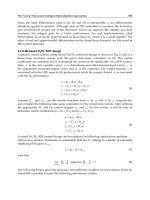Advances in PID Control Part 14 pdf
Bạn đang xem bản rút gọn của tài liệu. Xem và tải ngay bản đầy đủ của tài liệu tại đây (2.3 MB, 20 trang )
Advances in PID Control
250
Yu, C. C., 2006. Autotuning of PID Controllers: A Relay Feedback Approach. 2nd Edition,
Springer, 2006.
Wang, Z.P., Xiong, G.Z., Luo, J., Lai, M.Z., Zhou, W. (2000). A hard real-time communication
control protocol based on the Ethernet. In Proceedings 7th Australian Conference
on Parallel and Real-Time Systems, pages 161-170, Sydney, Australia, Nov. 2000.
Springer-Verlag. ISBN 962-430-134-4.
Zeilmann, R.; Gomes Jr.; J.M., Bazanella; A., And Pereira, C. E. (2003). Web-based Control
Experiments on a Foundation Fieldbus Plant, 5th IFAC International Conference on
Fieldbus Systems and their Applications, Aveiro, Portugal, July 2003, pp. 325-330.
Zhuang, M.; Atherton, D.P. (1993). Automatic Tuning of Optimum PID controllers. In: IEEE
Proceeding-D, 140, no 3, pp 216-224.
Jae Ho Hwang and Jae Moung Kim
WITLAB, INHA University
Korea
1. Introduction
Locating systems are categorized as macro or micro locating systems, depending on service
coverage. Macro locating systems offer wide coverage of over ten kilometers. These systems
are allowed large error margins of over ten meters. They are for use in a global positioning
system (GPS) [1] and in mobile locating systems between a mobile station (MS) and a base
station (BS) [2]. A micro locating system, by contrast, operates in a small coverage area of less
than ten meter, such as indoor environments where it is hard to use a GPS system.
A micro locating system requires a high accuracy of within one meter. Moreover, it requires
real-time calculation for more accurate estimation when the target node changes position.
Such a real-time locating system (RTLS) is frequently required in robotics applications.
However, the conventional direct calculation (DC) method requires a heavy computation load,
such as floating point calculation. This not only imposes a high computational load on an
embedded system, but also decreases the accuracy [3].
This chapter introduces a PID application in real-time locating system. A ToA algorithm is
used to obtain the target node coordinates, but a conventional DC method, which incurs heavy
calculation time, is not suitable for embedded systems. This paper proposes the use of a
P-control in the PID control algorithm to resolve real-time locating system issues. Performance
measures of the accumulated operator number and position error are evaluated. It is shown
that the PID method has less calculation and more robust performance than the DC method.
2. Conventional location system
To calculate the target node coordinates, the triangulation method requires more than three
fixed reference nodes for which the coordinates are already known. In this method, each
reference node calculates the distance between the reference and target nodes to count the
propagation time by using time of arrival (ToA) algorithm. The target node estimates
two-dimensional coordinates
(X
T
, Y
T
) using this information
The triangulation method is shown in Figure 1 [4]. This method consists of three known
reference nodes
((X
1
, Y
1
), (X
2
, Y
2
), and (X
3
, Y
3
)) and an unknown target node (X
T
, Y
T
). Each
reference node measures its distance (D
R1
, D
R2
, and D
R3
) from the target node. The DC
method uses the relation between the coordinates and the distance. Each distance is expressed
by the coordinates of the reference and target nodes, as shown in equation 1.
D
R
i
=
(X
T
− X
i
)
2
+(Y
T
−Y
i
)
2
=
X
2
T
+ Y
2
T
−2(X
i
X
T
+ Y
i
Y
T
)+X
2
i
+ Y
2
i
(1)
PID Application: RTLS
13
2 Will-be-set-by-IN-TECH
Fig. 1. The triangulation method using the DC method when the number of reference nodes
is three
These equations are simplified by squaring and repositioning, as shown in Equation (2).
X
2
T
+ Y
2
T
−2(X
1
X
T
+ Y
1
Y
T
)=D
2
R
1
− X
2
1
−Y
2
1
X
2
T
+ Y
2
T
−2(X
2
X
T
+ Y
2
Y
T
)=D
2
R
2
− X
2
2
−Y
2
2
X
2
T
+ Y
2
T
−2(X
3
X
T
+ Y
3
Y
T
)=D
2
R
3
− X
2
3
−Y
2
3
(2)
Using these equations, it is complex to calculate X
T
and Y
T
, so it is assumed that reference
node 3 is located at
[0, 0]. then total coordination are change as
X
T
,
Y
T
,
X
i
, and
Y
i
, which is
shifted values as shown in
X
T
X
T
− X
3
,
X
1
X
1
− X
3
,
X
2
X
2
− X
3
Y
T
Y
T
−Y
3
,
Y
1
Y
1
−Y
3
,
Y
2
Y
2
−Y
3
(3)
Then, the third equation (X
2
T
+ Y
2
T
− 2(X
3
X
T
+ Y
3
Y
T
)=D
2
R
3
− X
2
3
− Y
2
3
) is simplified with
X
2
T
+ Y
2
T
= D
2
R
3
, as shown in Equation (4).
X
1
X
T
+
Y
1
Y
T
=
D
2
R
3
− D
2
R
1
+
X
2
1
+
Y
2
1
2
X
2
X
T
+
Y
2
Y
T
=
D
2
R
3
− D
2
R
2
+
X
2
2
+
Y
2
2
2
(4)
To make the easy calculation, the complex constant value of equation 4 notate simple A and B
symbols. those are descried in following equations.
A
D
2
R
3
− D
2
R
1
+
X
2
1
+
Y
2
1
2
, B
D
2
R
3
− D
2
R
2
+
X
2
2
+
Y
2
2
2
(5)
Using those notations, the equation 4 will be changed as.
252
Advances in PID Control
PID Application : RTLS 3
X
1
X
T
+
Y
1
Y
T
= A,
X
2
X
T
+
Y
2
Y
T
= B
(6)
Next, the coordinates of the target node are obtained by using elimination of the
X
T
, and
Y
T
in both equation.
X
T
=
A
ˆ
Y
2
−B
ˆ
Y
1
ˆ
X
1
ˆ
Y
2
+
ˆ
X
2
ˆ
Y
1
,
Y
T
=
A
ˆ
X
2
−B
ˆ
X
1
ˆ
X
1
ˆ
Y
2
+
ˆ
X
2
ˆ
Y
1
(7)
Then, the real target node coordinates are compensated to the coordinate values of reference
3, which values are shifted as assumed. Finally, the coordinates are obtained, as shown in
equation 8.
X
T
=
A
ˆ
Y
2
−B
ˆ
Y
1
ˆ
X
1
ˆ
Y
2
+
ˆ
X
2
ˆ
Y
1
+ X
3
, Y
T
=
A
ˆ
X
2
−B
ˆ
X
1
ˆ
X
1
ˆ
Y
2
+
ˆ
X
2
ˆ
Y
1
+ Y
3
(8)
The DC method is complex and uses many multiple and floating point operations; therefore, it
is not suitable to embedded systems. Furthermore, the processing delay caused by use of the
DC method results in position errors when the target node is moved, and the method always
requires a substantial amount of calculation time whether the target node position changes or
not. These features cause a performance reduction when using applications such as a real-time
robotics locating system
3. PID algorithm application: RTLS
3.1 ToA algorithm using PID algorithm
The conventional method has the problem of heavy computation load for an embedded
system. Therefore, a new coordinate calculation method is necessary for use with RTLSs.
In this chaper, the PID calculation method is proposed to meet this need. The PID algorithm
is a generic control loop feedback mechanism widely used in control systems. It attempts to
correct the error between a measured process variable and a desired set point by calculating
and then performing an appropriate action that can adjust the process accordingly. This
algorithm involves three separate parameters: the proportional, integral and derivative
values. The proportional value determines the reaction to the current error, the integral
determines the reaction based on the sum of recent errors and the derivative determines the
reaction to the rate at which the error has been changing. The weighted sum of these three
actions is used to adjust the process via a control element such as the position of a control
valve or the power supply of a heating element, as shown in equation 9 [5] [6].
u
= K
P
e + K
I
edτ + K
D
de
dτ
(9)
Where K
P
, K
I
and K
D
are tuning parameters and e is the error value. The PID algorithm was
applied to the proposed coordinate calculation method. Figure 2 provides a more detailed
explanation of the coordinate calculation method.
First, the pseudo target node is placed at an arbitrary position. Subsequently, the distance
between the pseudo target node and each reference node is calculated, thereby giving the
253
PID Application: RTLS
4 Will-be-set-by-IN-TECH
Fig. 2. Triangulation method using the PID calculation algorithm
Fig. 3. A PID calculation block to obtain the target node coordinates
pseudo distance (D
pseudo1
, D
pseudo2
, and D
pseudo3
). Using the PID algorithm, the pseudo target
node converges to a real target node to control for distance error between the two positions.
To utilize the PID algorithm in the coordinate calculation, the PID controller block consists of
three blocks to calculate the coordinates, as shown in Figure 3.
First, the PID calculator obtains e by subtracting D
pseudo
,fromD
real
, as shown in equation 10.
e
(i)=D
pseudo
(i) − D
real
(i), i = {1, 2, . . . , N}
(10)
where i is the index of the reference nodes. Next, the PID controller block checks the error
between the actual distances and the pseudo distances, and the PID controller calculates u
using the input e value from each of the reference nodes.
u
(i)=K
P
e(i)+K
I
e(i)dt + K
D
de
dt
(11)
The coordinate controller adjusts the pseudo target node coordinates to be closer to the real
target node. These processes are explained by Figure 4 and in the following equations.
The u values change the coordinate value to compensate for the position of the pseudo target
node. It is assumed that the u values have the same vector as the D
pseudo
value. The
254
Advances in PID Control
PID Application : RTLS 5
Fig. 4. A coordinate calculation algorithm to obtain the u value from the pseudo target node
coordinates
compensation coordinates values (x
com
(i), y
com
(i)) then have a proportional expression, as
shown in equation 12.
x
com
(i) : x
re f
(i)=u(i) : D
pseudo
(i)
y
com
(i) : y
re f
(i)=u(i) : D
pseudo
(i)
(12)
Here x
re f
(i) and y
re f
(i) are calculated as X
i
− X
pseudoT
and Y
i
−Y
pseudoT
. The expressions are
changed as in the following equation.
x
com
(i)=
u(i)
D
pseudo
(i)
×
x
re f
(i)
y
com
(i)=
u(i)
D
pseudo
(i)
×
y
re f
(i)
(13)
The new coordinates of the pseudo target node are obtained by using the last pseudo target
node coordinates(X
pseudoT
, Y
pseudoT
), (x
com
(i) and y
com
(i)).
X
(n+1)
pseudoT
= X
(n)
pseudoT
−
N
re f
∑
i=1
x
com
(i)
Y
(n+1)
pseudoT
= Y
(n)
pseudoT
−
N
re f
∑
i=1
y
com
(i)
(14)
where N
re f
is the number of references.
Lastly, D
pseudo
, which is the feedback value for the next calculation, is obtained using a
distance calculator. This is shown in Equation (11). The pseudo target coordinates converge
to the real target node after the iteration process.
255
PID Application: RTLS
6 Will-be-set-by-IN-TECH
Fig. 5. The position error transition of the pseudo node using the PID method for each value
of Kp
D
(n+1)
pseudoT
(i)=
(X
(n+1)
pseudoT
− X
i
)
2
+(Y
(n+1)
pseudoT
−Y
i
)
2
(15)
The PID calculation method offers the advantage of continuous calculation because, in
contrast to the DC method, its calculation time is reduced by using information from past
positions. If the target node coordinates are calculated, the processing to calculate the next
position is further reduced. Furthermore, the PID calculation method does not require a
complex floating point operation. The PID calculation method is useful in embedded systems
which use compact micro-processors and specific applications, such as real-time or continuous
locating systems. Furthermore, this algorithm reduces the calculation process when the
number of reference nodes is increased.
3.2 Simulation and result
In this section, the performances of the DC method and the proposed PID calculation
algorithm are compared. The simulation environment is three reference nodes and one
target node. The reference nodes are located at [100, 100], [100, 5000] and [5000, 100] (mm),
respectively, and the target node is located at [3000, 3000] initially. The ranging result is set
to have an error of 0.01 0.1%. The PID algorithm’s parameter is set to P-control (K
P
= k
E
,
K
I
= 0, K
D
= 0).
First, the PID calculation process will be explained. Figure 5 shows the position error of the
pseudo target node versus the number of try times for each k
P
parameter (k
E
). The pseudo
target node converges to the target node, where the pseudo target node is located at the
coordinates of [2000, 2000] arbitrarily. As a result, the pseudo target node converges to the
target node after eight iterations with a high accuracy of less than ten centimeters, except
when k
P
is 0.1. The parameter of k
P
(k
E
) has an optimal tuning value when set to 0.5.
Second, the calculation time of the DC method and that of the PID method are compared
by counting the number of adders and multipliers when the target node has mobility. The
mobility of a target node is generated by a normal distribution random model, and the
256
Advances in PID Control
PID Application : RTLS 7
Fig. 6. Accumulated operation number result of the DC method and the PID calculation
method when target node has mobility
ranging error is set to 0.01%. The DC method requires 16 adders and 20 multipliers for
every calculation time. In contrast, the PID method requires 15 adders and 21 multipliers for
each iteration time and 3 adders when the target position does not change. The results show
the accumulated calculation time for each method. The calculation time of the conventional
method increase linearly. This indicates that the DC method is not related to the mobility
of the target node. In contrast, the PID method requires many operators compared to the
DC method at the transition region to obtain the target node position. After convergence,
the accumulated number of operators for the PID method shows fewer calculation operators
compared to the calculation time of the DC method.
Third, the performance of the conventional DC method is compared with that of the proposed
PID calculation method in Figure 6. The simulation parameters are the same as in the previous
iteration, and the ranging errors are set from 0.01% to 0.1%. As shown in the result, when the
ranging errors are small, performance enhancements are small. However, the PID method
performs better than the conventional method in cases of a high ranging error because the DC
method must use truncated data to operate in a small micro-processor system. In addition,
the PID calculation method has better performance when using four reference nodes, but it
does not require a complex calculation process.
4. Conclusion
This chapter describes an application of PID algorithm which is a coordinate calculation
method in locating systems. The conventional DC method occur a delay of calculation
time and gives inaccurate results when used in embedded systems or location system of the
moving target. Therefore, a novel method using a PID control algorithm is proposed here.
we used a P-control algorithm in this simulation. Therefore we show that this system will
require less calculation and shows robust performance when using RTLS applications such
as embedded locating systems, home networking systems and robotics positioning systems.
If more complex PID control algorithms, such as PI, PD, and PID-control, are used, location
257
PID Application: RTLS
8 Will-be-set-by-IN-TECH
Fig. 7. Position error of the DC method and the PID calculation method when the ranging
result has error
accuracy will be enhanced more. furthermore this concept can be also used other location
algorithm such as the TDoA method.
5. References
I. Getting. (1993), The Global Positioning System, IEEE Spectrum, Vol.30, Iss.12, Dec. 1993,
pp.36-47.
Y. Zhao. (2000), Mobile phone location determination and its impact on intelligent
transportation systems, IEEE Transactions on Intelligent Transportation Systems,
Vol., Iss.1, Mar. 2000, pp.55-64.
Kegen Yu and Oppermann, I. (2004),UWB positioning for wireless embedded networks, Radio
and Wireless Conference, p 459- 462, 19-22 Sept. 2004,
Jourdan D.B. and Dardari, D., Win, M.Z. (2006),Position Error Bound for UWB Localization
in Dense Cluttered Environments, IEEE International Conference, p. 3705-3710, June
2006
Panagopoulos H. Astrom, K.J. and Hagglund T. (2002), Design of PID controllers based
on constrained optimisation, Control Theory and Applications, IEE Proceedings, p.
32-40, Jan 2002
Fan Yanfie Ren Fengyuan and Lin Chuang. (2003), Design a PID controller for active queue
management, Computers and Communication, p 985- 990 vol.2, 30 June-3 July 2003
Jae Ho Hwang, Jae Moung Kim. (2010), ToA Coordinate Calculation Method Using a PID
Algorithm, IEICE Transactions on Communications p 1057- 1060 vol.E93-B, April
2010
258
Advances in PID Control
14
PID Controller Using FPGA Technology
Abdesselem Trimeche, Anis Sakly,
Abdelatif Mtibaa and Mohamed Benrejeb
Ecole Nationale d'Ingénieurs de Monastir-Département de Génie Electrique,
Laboratoire d’Electronique et de microélectronique - Université de Monastir,
Unité de recherche LARA Automatique de l’Ecole Nationale d’Ingénieurs de Tunis,
Tunisia
1. Introduction
Since the Years 60, the law of Moore predicts that the complexity in terms of built-in circuit
transistors doubles every two years, remain verified. The programmable FPGA circuits
(Field Programmable Gate Array) didn't escape to this law. Since the first FPGA, developed
like an evolution natural of the CPLD (Complex Programmable Logic Devices), these
circuits didn't stop winning in complexity and integrated henceforth until one billion of
transistors for the most recent generations. This increase of the integration level resulted in a
similar growth of the power of calculation of these circuits. The FPGAs have been used then
to make the fast samples of ASICs (Application Specific Integrated Circuits) and find since
some years their place in many domains of applications. However, the order of the
processes industrial requires more and more elements of powerful calculations. This type of
order is in the same way in perpetual evolution with the development of the numeric
circuits of calculation. Thus, the PID controllers represent the majority of the controllers
used in the industrial systems control. Of this fact, it will be necessary to digitalize the PID
algorithm. The modern digital control systems require more and more strong and fastest
calculation components. This type of elements becomes yet indispensable with the
utilization of some new control algorithms like the fuzzy control, the adaptive control, the
sliding mode control… [1]. Although the PID controllers are the oldest they represent the
most used controllers in the industrial control systems
2. Discrete PID equation
The PID algorithm consists of three basic modes, the Proportional mode, the Integral and
the Derivative modes. When utilizing this algorithm it is necessary to decide which modes
are to be used (P, I or D) and then specify the parameters (or settings) for each mode used.
Generally, three basic algorithms are used P, PI or PID.
The implementation of PID controllers using microprocessors and DSP chips is old and well
known [2] [3], whereas very little works can be found in the literature on how to implement
PID controllers using FPGAs [4].
Field Programmable Gate Arrays (FPGA) have become an alternative solution for the
realization of digital control systems, previously dominated by the general purpose
microprocessor systems.
Advances in PID Control
260
In our work we introduce a simple method for implementing PID controllers. Some other
contributions focused on proposing algorithms for tuning the coefficients of PID controllers
using FPGAs while the controller itself is still implemented in software.
In [5] the authors describe the architecture of a data acquisition system for a gamma ray
imaging camera.
In the past two years, Spartan II and III FPGA families from Xilinx have been successfully
utilized in a variety of applications which include inverters [6][7], communications [8][9],
imbedded processors [10], and image processing [11].
In our work, data acquisition for the PID controller, which is implemented using Xilinx
Spartan-3 Starter Kit Board, is based on 8-bitserial A/D converters extensible from Digilent
board AO1. Similar converters are utilized in [12] to implement an adaptable strain gage
conditioner using FPGAs.
The application of a PID controller in a feedback control system is shown in fig1, where ref
is the set point signal, y is the feedback signal, e is the error signal, and u is the control
input.
Fig. 1. A PID-based feedback control system.
The simplest form of the PID control algorithm is given by:
1 ( )
( ) ( ) ( )
p d
i
de t
u t k e t e t dt T
T dt
= + +
∫
(1)
According to the study done in [13] the digitized PID equation is brought back to:
0 1 2
1
( 1) ( 2)
k k k
u u b e b e k b e k
−
= + ⋅ + ⋅ − + ⋅ −
(2)
Where the coefficients b
0
, b
1
, and b
2
are evaluated by the expressions:
0
1
2
1 ;
1 2 ;
d
p
d
p
i
d
p
T
b k
T
T
T
b k
T T
T
b k
T
= ⋅ +
= ⋅ − + − ⋅
= ⋅
(3)
The Kp, Ti and Td, are PID parameters for tuning, and T is the sampling period in
seconds.
PID Controller Using FPGA Technology
261
3. Digital PID architecture
To improve the speed and minimize the cost while offering clearly good performances, the
adopted architecture used includes essentially three combinational logic multiplier, one
substractor three adders and three registers. The fig 2 gives the adopted architecture.
Indeed, this architecture requires the availability of all calculation operators in each phase.
Fig. 2. PID Architecture.
3.1 Conversion blocks presentation
The AIO1 board is a peripheral board designed to work with Digilent’s family of system
boards. The AIO1 contains analog to-digital and digital-to-analog converters from Analog
Devices, two dual op amps, a variety of analog signal I /O connectors, and a solderless
breadboard. All analog components use an on-board 5VDC voltage source. All unused I/O
signals are passed through the AIO1 board so that it can be used between a system board
and other peripheral boards.
The AIO1 uses an 8-bit, 200Ks analog-to-digital converter (the AD7823), and an 8-bit, 1 MHz
digital-to-analog converter (the AD7303), both from Analog Devices. The AD8534 op amps
(also from Analog Devices) can drive 250mA outputs rail-to-rail with a 3 MHz bandwidth,
so many useful devices can be driven directly.
Fig 3 describes all the components of this block.
3.2 Analog input interface
FPGAs are well suited for serial Analog to Digital (A/D) converters. This is mainly because
serial interface consumes less communication lines while the FPGA is fast enough to
accommodate the high speed serial data. The AD7823 is a high speed, low power, 8-bit A/D
converter. The part contains a 4 µs typical successive approximation A/D converter and a
high speed serial interface that interfaces easily to FPGAs. The A/D interface adapter
(ADIA) is implemented within the FPGA (Figure 5). Inside the FPGA, this adapter facilitates
parallel data acquisition. Sampling is initiated at the rising edge of a clock applied at the line
sample. The timing diagram of the communication protocol is illustrated in figure 4. The
whole conversion and acquisition period is 5.4 µs allowing sampling up to a rate of 185 Kilo
Sample per second. This rate is more than sufficient for most PID control applications.
Advances in PID Control
262
Fig. 3. Diagram of DIGILENT AIO1.
Fig. 4. A/D interface converter.
Fig. 5. AD7823 Timing Diagram.
The output coding of the AD7823 is straight binary. The designed code transitions occur at
successive integer LSB values (i.e., 1 LSB, 2 LSBs, etc.). The LSB size is = VREF/256.
ADIA
Convst
Vin+
Sclk
CLK
Sample
(reset)
ad_convst
ad_sclk
reading
FPGA
AD7823
PID Controller Using FPGA Technology
263
3.3 Analog output interface
The AD7303 is a dual, 8-bit voltage out Digital to Analog (D/A) converter. This device uses
a versatile 3-wire serial interface that operates at a clock up to 30 MHz. The serial input
register is 16 bits wide; 8 bits act as data bits for the D/A converter, and the remaining 8 bits
make up a control register. It is interfaced to an FPGA as illustrated in Figure 6. The D/A
interface adapter (DAIA), which is implemented within the FPGA, facilitates parallel data
input for the dual D/A converters. The timing diagram of the communication protocol is
illustrated in figure 7. The transmission period of a sample is 680 ns allowing D/A
conversion at an excellent rate of 1.47 MHZ.
Fig. 6. A/D interface converter.
Fig. 7. AD7303 Timing Diagram.
Any DAC output voltage can ideally be expressed as:
VOUT = 2 × VREF × (N/256) where: N is the decimal equivalent of the binary input code.
An N range from 0 to 255xVREF is the voltage applied to the external REF pin when the
external reference is selected and is VDD/2 if the internal reference is used.
3.4 Implementation results
The proposed based PID controller is implemented using the Xilinx Inc FPGA technology
and can be used as a general purpose controller for different applications. The simulation
results obtained with the generated VHDL, in this work, the ModelSim® simulator was
used. The circuits for the PID controllers have been obtained by logic synthesis and place
DAIA
SYNC
Vin+
Sclk
Vin-
DIN
CLK
Sample
(reset)
dac_SYNC
dac_sclk
dac_din
FPGA
AD7303
Advances in PID Control
264
and route using Xilinx ISE 7.1i, from the VHDL representation generated by the static
analyzer. We use a Xilinx Spartan-3 xc3s200-ft256 -4 FPGA. The results presented herein are
estimations directly obtained from Xilinx ISE 7.1i.
Fig. 8. Design properties.
Table 1 shows the minimum number of multiplications, additions and registers required for
the PID controller without conversions block.
Multiplication 3
Addition 3
subtraction 1
register 3
total 10
Table 1. Arithmetic Number for PID controller.
The PID controller block, into a complete control system consisting of analog and digital
I/O, is illustrated in figure 9.
Fig. 9. PID Controller Block.
The simulation results adapted to this block is shown in figure 10.
Inputs of
VHDL
algorithm
Outputs of
VHDL
algorithm
PID Controller Using FPGA Technology
265
Fig. 10. Simulation diagram of PID controller block.
The synthesis of PID controller block using a Xilinx Spartan-3 xc3s200-ft256 -4 FPGA gives
the following results.
Fig. 11. Devices utilizations summary for the PID controller Implementation.
A design which is efficient in terms of power consumption and chip area means that the
FPGA chip can be used to accommodate more controllers with adequate speed and low
power consumption, resulting in a cost reduction of the controller hardware.
4. Application of PID controller using FPGA technology to command a
system of second order
4.1 System presentation
The figure 12 describe the system of second order.
Advances in PID Control
266
Fig. 12. Installation Diagram of the system of second order.
The values of all the components are:
R = 12 k
R
1
= 15 kΏ
R
2
= 10 kΏ
C
1
= 6,8 nF
C
2
= 22 nF
The Transfer function of the system is given by the following equation
ܩ()=
ೞ
(
)
(
)
=
ೞ
ଵା
మ
ഘ
బ
ା
ቀ
భ
ഘ
బ
ቁ
మ
మ
(4)
With:
ܭ
௦
=
ோ
మ
ோ
భ
=0,67 : static gain
߱
=
1
ܴ
ඥ
ܥ
ଵ
∙ ܥ
ଶ
=6,81 ∙ 10
ଷ
ݎ݀/ݏ
݉=
ට
మ
భ
=1,80>1 : Amortization factor
While permuting the positions of C1 and C2, the amortization factor becomes:
݉=
ඨ
ܥ
ଵ
ܥ
ଶ
=0,56<1
4.2 Experimental result
At the time of the order of the system two cases appear; when the amortization is m>1 and
m <1.
4.2.1 Experimental results for an amortization m>1
4.2.1.1 System answer results in open buckle
For an order (ref) of the order of 2V applied to the system in BO one gets the answer y (t)
presented on the following figure.
PID Controller Using FPGA Technology
267
Fig. 13. System Answer in open buckle
(
݉>1
)
.
According to this answer, one verifies that the tension of exit stabilizes without oscillations
(m>1) nearly to the value 1,4V, that corresponds more or less to the theoretical value:
ܸ
௦
=ܭ
௦
∙ ܸ
=0,67 ∗ 2=1,34V.
4.2.1.2 System answer results with P regulator
For an order (ref) of the order of 2V applied to the system ordered by a Proportional
regulator (P) with KP = 2, one gets the answer y(t) presented on the following Figure
Fig. 14. Answer of the system ordered by proportional regulator P.
Advances in PID Control
268
One notices that this answer presents a static mistake of the order of 40%. Theoretically this
mistake is given by:
ଵ
ଵା
∙
ೞ
∙ 100%= 42%.
4.2.1.3 System answer results with PI regulator
For an order (ref) applied of the order of 2V to the system ordered by a PI regulator with
KP=2, KI=0.5, one gets the answer y(t) presented in the following figure:
Fig. 15. Answer of the system ordered by PI regulator (݉>1).
One notices the annulment of the static mistake well thanks to the introduction of the I
action.
4.2.2 Experimental results for an amortization m<1
4.2.2.1 System answer results in open buckle
For an order (ref) of the order of 2V applied to the system in BO one gets the answer y (t)
presented on the following figure









